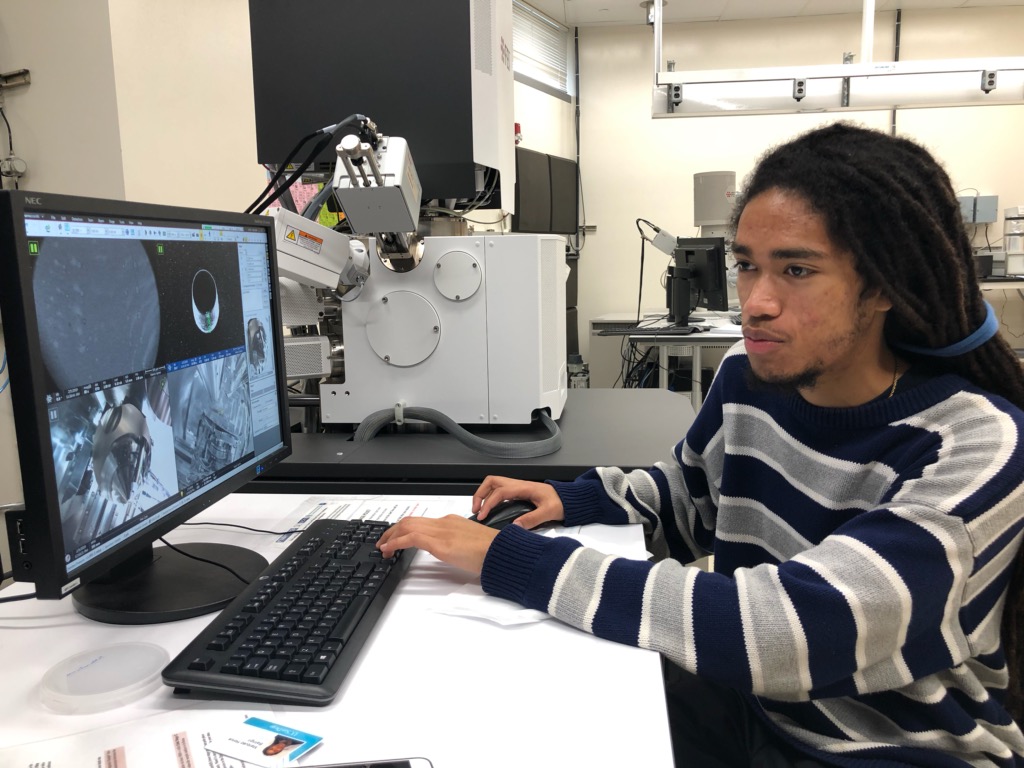QI Student Innovator Marquez Balingit and his Interest in the Nanoscale

QI encourages the curiosity of student innovators. We offer training programs that give students the chance to conduct research, prototype technologies and test those technologies in the field. Meet one of our students: Marquez Balingit, a third year undergraduate majoring in nanoengineering.
As a high school sophomore in a robotics club, Marquez couldn't help but wonder: How do these parts work and how do circuits communicate with each other?
Once he realized the answers to his questions could be answered within the major of nanoengineering, he was set to pursue one of his main interests — understanding what things at the nanoscale or submicron level look like.
Now, Marquez tackles this question at the Nano3 lab. Here, he works to teach internal and external users unfamiliar with the scanning electron microscope, SEM, how to use it independently. Unlike regular optical microscopes, SEM does not use photons. Instead, they use electrons, which allows for smaller features in the 1 micron scale, approximately ⅕ the size of a human red blood cell.
"I like the idea of being the bridge of information by gathering some knowledge, filtering out the details and explaining it to someone clearly," Marquez said. "I learn how to use high tech equipment and understand the standard operating procedures to be able to articulate that to other people so that they can use it on their own."
Outside of training users how to use SEM, he also works on service measurements for internal and external users. When users are working on their projects and need measurements about their sample's material, Marquez works on imaging their sample to figure out the features that they want by tilting and manipulating the current.
In doing this, he feels challenged to get a clear, high resolution image and excited to see something he's never seen before.
"Sometimes things I see in textbooks, I end up actually imaging which is pretty amazing because I never thought I'd be able to. In my textbooks, a lot of things are in the 10 microns and 5 microns and I wondered how they even get these images. Now, years later, I'm getting images that are roughly similar to that," Marquez said.
The Nano3 lab is also looking to increase outreach with the SEM by remotely connecting with high schools and community colleges to show them the full capabilities of the SEM and what it can provide from an educational standpoint. Marquez feels like this will help bridge the gap between college and high school curricula in nanotechnology by bringing this information to them. By magnifying everyday objects like pennies and ballpoint pens, Marquez also hopes that using SEM will inspire young students to pursue an education/career in a STEM field.
In the future, Marquez sees himself creating a nonprofit company specializing in a form of energy conversion, battery or generator that is efficient in every aspect: cost, power conversion and practicality. He hopes that it can be free and practical for third world countries, giving them more autonomy so that they can power themselves.
Marquez himself is inspired by the works of Nikola Tesla. From his perspective, Tesla's main desire was to create free energy by harnessing and manipulating existing energy on earth and within the air so that everyone can access it.
Media Contacts
Alicia Clarke
(858) 822-5825
amclarke@eng.ucsd.edu
